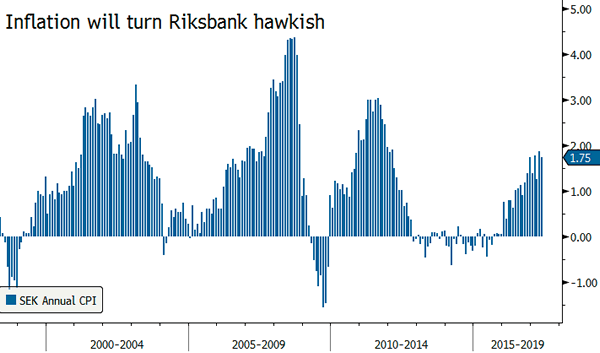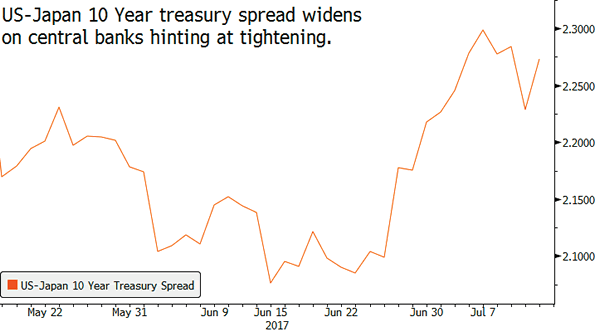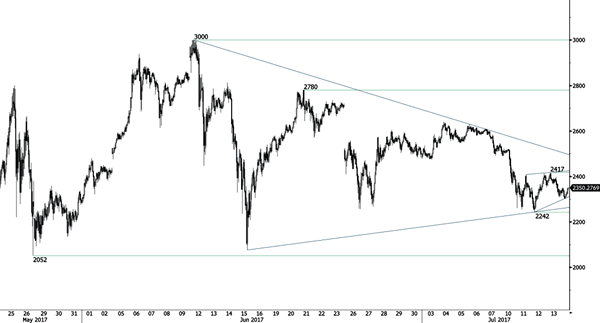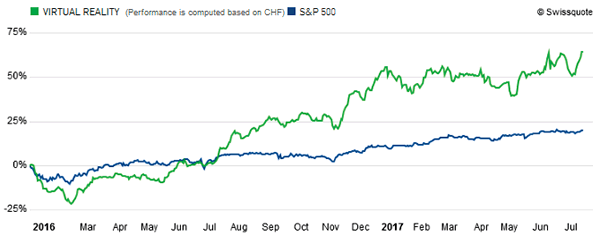- Eyes On Inflation in Sweden – Peter Rosenstreich
- ECB rate decision up next – Peter Rosenstreich
- Yen Weakens As Central Banks Hint Of Further Tightening – Yann Quelenn
- Bitcoin: Trade The Fork – Yann Quelenn
- Virtual Reality
Economics – Eyes On Inflation In Sweden
With the shift of global central banks towards "normalizations" the debate over inflation creation has been renewed. Yet the debate looks to have ended for policymakers. Central banks are no longer waiting for wage growth to convincingly turn into domestic inflation before tightening monetary policy. For those traders looking to build a mid-term trading approach using fundamentals a core focus on price data is critical. Judging from the market’s reaction to the US strong labor data (muted) verse inflation (significant), we clearly see that adjustments in inflation data and expectations will trigger an asymmetrical market reaction. Sourcing outperformers in the G10 we need to isolate those nations that will struggle with rising prices.
Recently, the Riksbank ended its easing bias taking a baby, but real, step toward normalization by removing possibility of additional repo rate cuts in projections. The banks held on to its cautious stance and provided no indication that a shift towards hawkishness was coming soon. Yet since then the diminishing growth risks, higher inflation reads and modification of tone globally suggests a change is coming. Sweden June CPI inflation quickened more than markets and central banks forecast expected by printing at 1.7% y/y. On the release, front-end yields further steepening reinforcing the view of 10bp in hikes over the next 8 months.
Yet persistent inflation over the next few months, which is likely, increases the risk of an earlier move. Sweden sensitivity external demand makes Riksbank nervous. Considering the broad trade data improvement the risk are high that price pressures continue to build in Sweden. Steady improvement in domestic data indicates that inflation will remain elevated and accelerated expectations of tightening. We remain bullish on SEK especially against low yielding currencies such as CHF and JPY.

Economics – ECB Rate Decision Up Next
Summer trading is clearly on us. Despite the best-effort hype of corporate earnings and constant political uncertainty emulating from the US, volatility and liquidity continues to dry up. The expectations for global central bank shift towards normalizations that sent shockwaves through financial markets, pushing yields up 25bp across the curve, has faded. While central bank after central bank in the G10 seem to have suddenly reverse bias investors were left with a lot of rhetoric and not much evidential support. Yellen toed the line but perhaps provided slightly less hawkish commentary in front of congress. While the BoC seem to have backed shift with a 25bp hike, external economic headwinds (specifically soft oil prices) and reality of modern inflation dynamics makes aggressive tightening less likely.
But the main event will be ECBs 20th July rate decision and press conference markets. Draghi recently smashed conventional wisdom with his hawkish shift sending EUR on a bullish tear. The change in ECB tone was response to solid growth (both domestic and international) rather than reassessments of inflationary risk. Draghi will have a challenging time to dial back his hawkish shift while at the same time prepare the markets for tapering on 26th October (hawkish action while not seemingly sounding hawkish). We anticipate the ECB will remove emergence measure sooner then expected. And by September have the ground work for a reduction in asset purchases. We expect the ECB QE program to be finalized around mid-2018 (depending on market reaction and economic data) and rate increase by the end of 2018.
Economics – Yen Weakens As Central Banks Hint Of Further Tightening
As the US Federal Reserve signals the end of zero-interest-rates, and the interest rate spread between 10-year government bonds from the US and Japan widens, the JPY just keeps on falling. The USD is now at around 113 JPY, the yen’s weakest since mid-May, compared to levels of around 100 JPY in September of 2016. JPY’s movements against the EUR have been similar.
This is good news for the Bank of Japan, which for years has been battling deflation, and is likely to capitalise on a softening yen to help reignite inflation. But at this step, this is only hope as no action from the BoJ has sparked an increase in consumer prices. For the time being, the Japanese inflation only lies at 0.4% y/y far from the central bank’s target of 2%.
Also dragging the yen down is a slowing in the Japanese economy. This weeks’ data marked the publication of Japan’s machinery orders for May 2017. They were down 3.6% from April, which in turn had fallen 3.1% from March levels. May industrial production also came in lower at -3.6% after a decline of -3.3%.
We consider that the yen’s decline is mostly driven be monetary tightening from other central banks: first the US Federal Reserve, then the ECB, with similar moves expected from the Bank of England, Bank of Canada, Norway’s Norges Bank and Sweden Riksbank.
Meanwhile, nothing has changed in BoJ’s monetary policy. The Japanese institution is still set to purchase an unlimited amount of bonds at a defined yield. The Bank of Japan looks likely be the only major central bank that will not to raise its interest rates this year. This is one great reason why investors are staying away from the JPY.
However the relative geopolitical calm should not make investors forget that the yen is constantly under pressure and that upside risk may arise very quickly due to the political stability of the country.

Digital Currencies – Bitcoin: Trade The Fork
The most infamous digital currency has exploded this year reaching $3000 before bouncing back lower. Since then, downside pressures are increasing and the cryptocurrency market has entered a bear market. Yet, there is a very important date which accounts for the sudden selling. On 1st of August there may be the most important event for this elderstatesmen’s of cryptocurrency.
Indeed, the future of Bitcoin as we know it may change. First let’s understand the issue. For the time being Bitcoin blockchain is unable to process massive number of transaction (around 7 per seconds) and the only way to increase speeds of transaction is to increase the size of the blockchain (size of the decentralized database) by modifying the code.
There are two changes likely to happen: A soft or a hard fork. A fork is simply a change in the blockchain structure. A soft fork ensure that new blocks are valid in older version while the hard fork renders impossible to use old blocks but requires larger acceptance (by miners, wallets, merchants).
What makes markets nervous is that both soft and hard fork needs large acceptance (WAY larger for the hard fork) and both may lead to a split like what happened with Ethereum now split in Ethereum (ETH) and Ethereum Classic (ETC).
At this stage, markets believe the soft fork will win and we also consider the Bitcoin split unlikely at this stage. This is why we remain bullish on Bitcoin and we target $2500 for one bitcoin in the short-run as a relief rally.
Technical Analysis
- Bitcoin is located in a medium-term bearish trend while very short-term momentum is slightly bullish. Hourly resistance can be found at 2417(13/07/2017 high) and hourly support is given at 2242 (12/07/2017 low).
- In the long-term, the digital currency has had an exponential growth. There are decent likelihood that the asset will consolidate above $1500. Long-term support is given at $1464 (04/05/2017 low).

Themes Trading – Virtual Reality
Is this a simple gadget, a new tech bubble or a revolution? It’s hard to say at the moment, but one has to admit that the concept is fascinating. Virtual reality takes users to simulated worlds. It might sound like a new generation of video game consoles at best, but we believe it’s going to be much more than that. For example, visiting a potential new home or looking for a doctor’s advice from the comfort of your home could become a new normality. Features could go well beyond mere play or entertainment: in fact, we believe this technology could represent the same kind of step change as the introduction of smartphones and PCs – a whole new way to seek out information and interact.
According to a recent survey by statista.com, the user base is also set to explode, rising to 171 million users from 43 million this year. Forbes is also saying that revenues could reach CHF 21.2 billion in 2018, compared with around CHF 150 million this year. Suffice to say that potential growth may be immense.
For this theme, we have chosen companies that are either mainly focused on virtual reality or have adopted a strategic stance towards this new technology. For example, AMD and NVIDIA have designed a full range of graphics cards ready for virtual reality, while Qualcomm is developing virtual reality applications. The selected companies are also investing significant amounts, demonstrating that things are moving apace. Facebook bought Oculus for $2 million in 2014, while Qualcomm and AMD invested $30 million in Matterport for virtual reality real estate tours. There will not be any half-and-half results: either the market will explode or it won’t!













